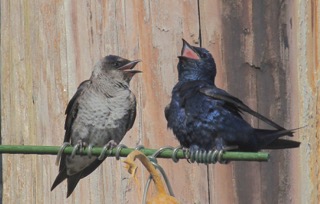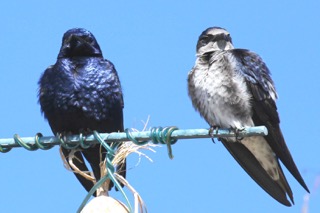By Sharon Moore
Order: Passeriformes
Family: Hirundividae

This beautiful, highly sociable swallow subspecies is a favorite for many of us. Migrating north in large flocks in spring, western Purple Martins establish residence in small colonies throughout California, Washington, Oregon and British Columbia. Since these birds prefer nesting sites near saltwater bays, they head locally for places such as the Port of Olympia near Hearthfire, Woodard Bay, Zittel’s Marina, the Nisqually Reach Nature Center and the Boston Harbor Marina. After a long, grueling migration of up to 5,000 miles from the Amazon Basin, Bolivia, Argentina and elsewhere in South America, they arrive ready to forage on our massive summer insect populations that will allow them to breed and raise their young.
Western Purple Martins are strong flyers and incredibly aerodynamic. Their long, slim wings and longish, forked tails allow them to make quick turns, arches and glides, tracing wide circles in the sky as they hunt insects. With such strength and agility they are able to soar significantly higher than other swallows, up to 500 feet or more, for the insects they eat exclusively year-round. Their tasty menu may include beetles, mayflies, cicadas, flies, moths, crickets, wasps, bees, caddisflies, spiders and termites. Not only do they hunt all their food in flight, they also obtain all their water that way as well. Skimming the surface, they scoop it up with their bills while on the wing. Rarely landing on the ground, martins are only down here with us to quickly gather nesting materials and pick up small bits of grit to help them digest insect exoskeletons.
At 8 inches long, the western Purple Martin is the largest of all the swallow species. The female’s coloring is distinct from the male’s appearance with her gray-blue head and gray throat, chest and neck collar. Her stomach is mottled white and her face, back and tail are black. It’s important to note that the first year, immature male resembles the female in coloring. The mature male is distinctive – entirely dark, iridescent purplish-blue in his full body appearance.
The martin is one of our most popular migrant visitors not only for its beauty and agility but also for its songs. Though its voice consists of generally low-pitched, liquid warbles, in fact, these birds have up to ten distinctive vocalizations. The croak song, containing grating and clicking sounds, is the male’s courtship signal in the presence of females. The chortle song is the female’s courting vocalization. Their hee hee call signals a potential male fight over territory. Uttering choo calls helps the females keep track of their young fledglings. The two primary alarm calls for both sexes sound like zwrack and zweet. The most resonating vocalizations occur when bonded pairs sing the lovely dawn song together in the early morning hours.

At the beginning of the June mating season martins search for woodpecker holes or tree snags but are using more manmade houses today due to environmental destruction along our Pacific Coast, Puget Sound and coastal rivers. The female appears to choose her mate based primarily on her approval of the nest site the male is occupying. Though the two will pair bond, both sexes often mate outside that primary bond. The male and female together build the nest of twigs, plant stems, mud and grass. The female lays a clutch of 3 to 6 small, smooth, white eggs that she incubates for 15 to 18 days. Both parents feed the young until they fledge in 26 to 31 days. When the nestlings hatch they are entirely helpless with bare, pink skin. Once they fledge and reach the juvenile stage, their future is unpredictable. Though we have no reliable information on these birds’ survival rates or maximum ages reached, the oldest banded Purple Martin female on record was found in Illinois, having lived at least 13 years and 9 months.
As to whether our western Purple Martin sub-species population is stable, there is field-collected evidence that their numbers have been declining since at least the 1960’s. Mortality rates are generally high in migratory species due to birds’ exhaustion and insufficient food availability on their long flights. Then, too, martins, specifically, face intense competition from Starlings and House Sparrows for nest sites. Though male martins will attack those birds to protect their nest sites, the martins are less able to save their young from local predators such as gulls, crows and Bald Eagles that can wreak havoc on martin colonies.
In an effort to stabilize and increase these “at risk” western Purple Martin numbers, the Western Purple Martin Working Group was formed to bring together local government entities, wildlife biologists and private citizens to focus on long-term recovery and conservation of the subspecies. By increasing the number of nesting sites in natural cavities (i.e., trees and snags) the Working Group is goal-setting to significantly raise the number of nesting pairs. To assist with that effort, Black Hills Audubon Society volunteers have, since 2017, been providing martin nest boxes at the Boston Harbor Marina. These are designed and placed out over the water to resist Starling and House Finch habitation and provide good access to insect populations. The BHAS data collection continues in an effort to establish whether that particular martin colony’s numbers are stabilizing, decreasing or, hopefully, increasing.
Beyond these immediate challenges, the western Purple Martin faces a longer-term serious threat. Scientists have a specific concern over whether martins will have the ability to cope with climate change. As temperatures rise, causing disruption in aerial insect populations, they wonder whether martins will be able to adapt successfully? An article in the April 15, 2015 issue of Living Bird describes climate change field studies that may have relevance for the martins’ future. Since most migrant species depend on a stable climate pattern for the annual feeding opportunities they need to successfully breed, the question is what the migrant populations will do when that food peak of insect emergence shifts forward as temperatures rise? Considering that many migrant bird species are currently already under stress for the reasons previously mentioned, the fact that global warming is coming at such high speed could be catastrophic for many species. When the plants and insects they depend on are shifting their patterns faster than the birds can respond, are the migrants headed for what scientists have labeled “ecological mismatch?”
In an attempt to document birds’ responses to these climate challenges, recent studies have found that short-distance migrants such as the Ruby-crowned Kinglet and Tree Swallow seem to be responding fairly well to climate change by adapting their arrival time to earlier springs. In contrast, however, long-distance species such as the Wood Thrush and Purple Martin have not significantly pushed their arrival dates ahead. Faced with earlier spring warming in the northern U.S., the martins have not been appearing sooner to take advantage of the earlier food availability. So, if the martins could sense somehow that they needed to be here sooner, could they just fly faster? Though martins have never been thought to be unusually fast flyers, when researchers attempted to track martens’ flying speed, they found one female that flew 4,500 miles in thirteen days – approximately 340 miles per day. Given such an amazing speed, ornithologists agree martins may simply not be able to fly any faster. While field studies continue, researchers currently suggest that a migratory schedule adjustment in Purple Martins may come only through natural selection and that will take many generations. In the meantime martin survival will be at more risk as they continue to migrate on ancient internal schedules, falling farther and farther behind changing peak periods of aerial insects caused by global warming in our Pacific Northwest coastal region.
Do take time to visit the western Purple Martin colonies in our locale. At the Boston Harbor Marina you’ll find an interpretive sign with photos explaining these birds’ life cycles. They’re most active in the early mornings and evenings. Their best vocalizations are the dawn songs though they continue to warble through much of the day. Once the fledglings have left the nest, as juveniles they learn to hunt and practice flying. Then, in August, their colony regroups with other colonies to begin their return flight of thousands of miles to South America.







